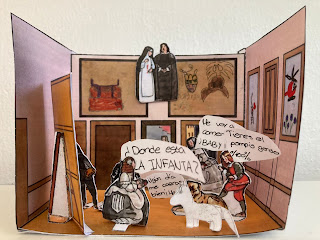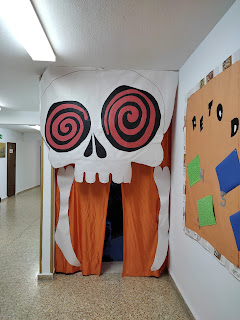UNIT 0: WHO'S WHO?
Hi guys! Do you remember this period of the Spanish history?
This historical period is known in Art as the GOLDEN AGE, do you know why?
Yes, during this period there were many artists and writers who became famous and achieved worldwide recognition. In this unit we are going to focus on the most well-known artist of all of them:
DIEGO VELÁZQUEZ
And we will learn about his most famous painting... Guess which?
After this brief introduction, let's analyse in more detail these mysterious work of art, in which Velázquez played with light and perspective and which you can admire at the Prado Museum:
Once that we know who is who in the famous painting, will you be able to reproduce it in 3D?
Let's wait for the results...
And here they are... our reinterpretations of Las Meninas:
HALLOWEEN: LET'S BUILD A GRAVEYARD
Halloween is here again and this time we have decided to celebrate it at school creating a "Museum of Horrors".
Whithin the museum, every level has been assigned a corner to decorate or display their Halloween crafts.
Six graders are in charge of decorating the stage and we have decided to build a graveyard. For this, they have been making tombs out of recycled cardboard and some other decorations to recreate a creepy environment, like spooky eyes and hunging bats.
And here we have the result:
Now, all we can do is... to wish you a very Happy Halloween!!!
UNIT 1: THE MODERN VITRUVIAN PERSON WANTED
Who do you think we are looking for?
Have you ever heard of the Vitruvian Man? Who was he?
He wasn't a real person, but a drawing made by the famous Italian artist (among other things) Leonardo da Vinci in about 1490.
Could you tell any other work of Art made by him?
But don't lose the perspective... let's focus on...
The Vitruvian Man:
The drawing is made in pen and ink on paper. It is a male figure standing in two positions, which are superimposed (drawn over the top of each other). The figure is standing inside both a circle and a square.
The drawing (which is accompanied by pieces of text written by the Roman architect Vitruvius) is also known as "Proportions of Man" because it is based on the ideal proportions of a man's body, and how they relate to geometry. These proportions were described by Vitruvius in Book III of his treatise De architectura, where he described how the ideal body should be. Da Vinci took this treatise on ideal proportions to practice and named the result after the famous architect.
Currently, the Vitruvian Man is stored in the Gallerie dell'Academia in Venice, Italy; and it is displayed only occasionally.
(This text has been adapted from the Kiddle Encyclopedia: https://kids.kiddle.co/Vitruvian_Man, last modified on 16 July 2021, at 09:44.)
Since Venice is a little far from our school, let's see if we can find any Vitruvian person round here...
Follow these instructions and find out whether there is any among your classmates.
Once we end our research, we will reproduce some modern Vitruvian people... After all, we are all perfect creatures, aren't we?
UNIT 2: LET'S GO GREEN, LET'S GO HEALTHY
After learning about nutrition, we already know it is important to eat healthy food in order to help our body systems to work properly. A diet rich in fruits and vegetables in essential for our health. But can we give these "super foods" an alternative use? Yes... they can be more than a source of important nutrients... and Giuseppe Arcimboldo realised that a few centuries ago.
But... who was this man? Ket's watch this video and learn a little about him...
Now that we know who Arcimboldo was, let's take a look at his original and amazing paintings:
 |
| Spring |
 |
| Summer |
What can you see in this painting? Just a still life?
Sure? Let's turn it upside down...
Let's play once more with Arcimboldo's reversibles... what can you see?
Now, do you remember the collage technique from last year? It's time to see what you can create out of a bunch of fruits and veggies photos... Do you accept the challenge? Here you have some ideas...
Here we have the brilliant results...
UNIT 3: NOW IT'S TIME TO PLAY WITH GEOMETRY
We have already proved that a healthy diet can be turned into art... but what about geometry? Now that you are doing some research on geometric bodies in Math, it's time for a new challenge...
Piet Mondrian is famous for creating works of art out of lines, geometrical shapes and primary colours...
His aim: to bring peace and harmony to this turbulent world through simplicity. It seems very appropriate after having celebrated recently the School Peace Day, don't you think?
But first, let's see who was Piet Mondrian...
So it seems that Mondrian created a style of his own that can be used as a pattern to decorate any shape in a harmonious and simplistic way... we'll see now how to do it...
You can choose to draw your name in Mondrian style:
Or any other shape of your choice. Just make sure you fill in most of your canvas with it...
Let's see what you can do with a few lines and the three primary colours... But don't forget that white spaces will help you to balance your composition...
Here we are:
ST PATRICK'S DAY IS COMING...
By now all of you are already familiar with the Irish big day, although St Patrick's Day has become more and more popular all over the world with time and nowadys it is celebrated in many countries.
We all know about St Patrick's story and how he brought catholicism to Ireland and expelled the snakes from the emerald island... do you remember?
But, as the video explains, today's celebrations are not only about St Patrick himself. On the contrary, these festivals around the world mostly celebrate Irish culture and traditions, as you will see in the next video...
Definetely, shamrocks and leprechauns are very much present in these celebrations and both of them are related to good luck...
Let's focus on this idea... Would you feel luckier if you found a four-leaf shamrock or caught a leprechaun?
Or are you already lucky enough? I'm sure you have a thousand reasons that make you feel lucky... Let's think about them and make a list on the whiteboard all together...
Now that we have the list, choose YOUR six reasons and let's make a craft to decorate the classroom for this coming St Patrick's Day:
You will be given six heart shapes. Use them as templates to draw six green hearts on green construction paper. Then write one of these six reasons that make you feel lucky on each green heart and fold them in half. Then glue them on a black construction paper forming a three-leaf shamrock, like the one on the image:
Finally, we will hang them all around the classroom so that we dont' forget how lucky we are.
UNIT 5: LET'S MEET A COURT PAINTER
What's a court painter? Do you know any already? Put your memory to work and let's remember,,, Yes! We had already met Diego Velázquez, but there have been many more... By the time Carlos III and his son, Carlos IV, were kings of Spain there was a court painter that became very famous in Spain at that time and nowadays is acknowledged world wide. His name....
FRANCISCO DE GOYA Y LUCIENTES
In Social Sciences we have already seen some of his paintings, where he portrayed the horrors of the Spanish War of Independence, like the 2nd and the 3rd of May. Do you remember? But not only did he paint this type of scenes, he also painted popular scenes of Spanish daily like:
"The blind man's bluff"
"The Puppet"
However, he became world-famous because of his portraits. Let's take a look to this one:
Can you recognise anyone we have studied in Social Sciences? And doesn't it look like to one painting we have already worked on? Time to refresh your memories again...
Other very well-known portraits by Goya are "The naked maja" and "The clothed maja". Do you know who is the woman that appears in these paintings? And who do these two paintings belong to? As many other masterpieces, they have mysterious story behind... let's discover it...




























































.jpg)
_por_Francisco_de_Goya.jpg)






No comments:
Post a Comment
Note: Only a member of this blog may post a comment.